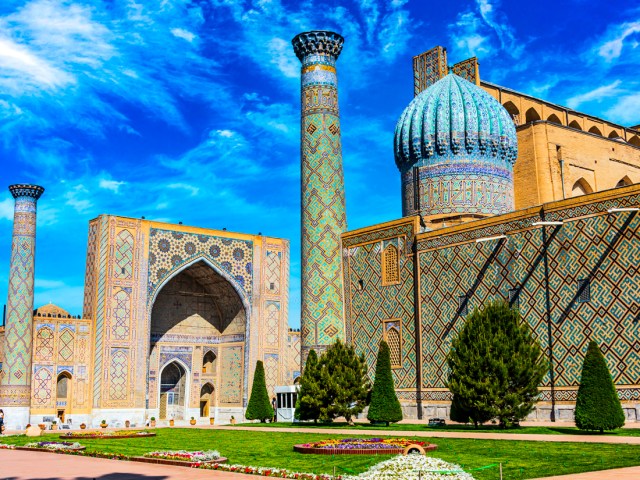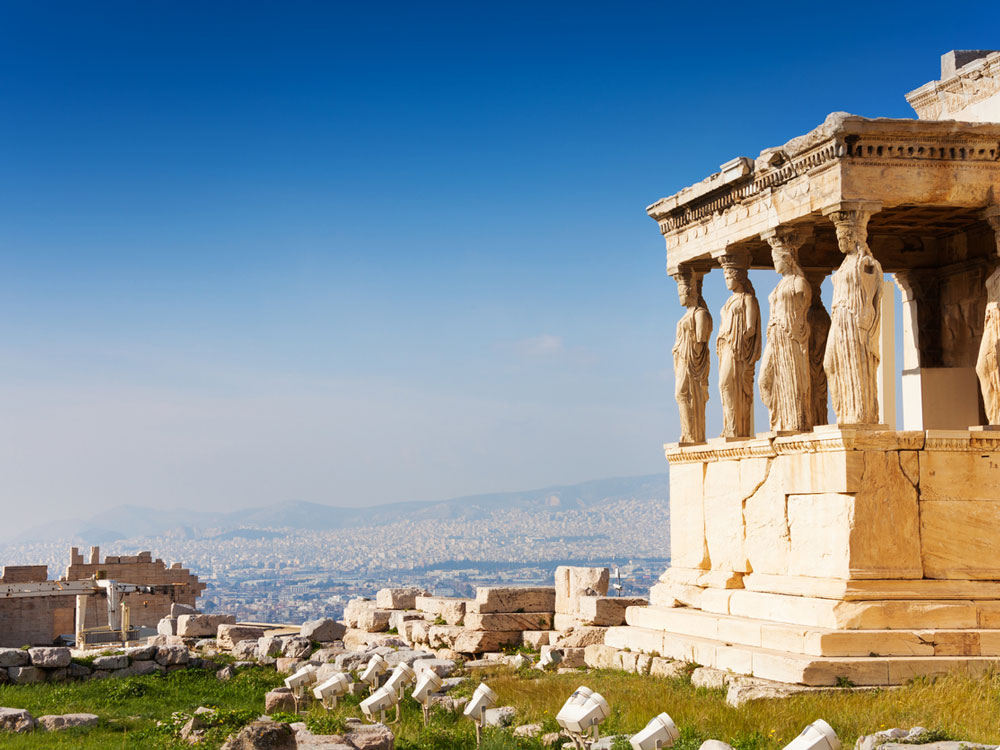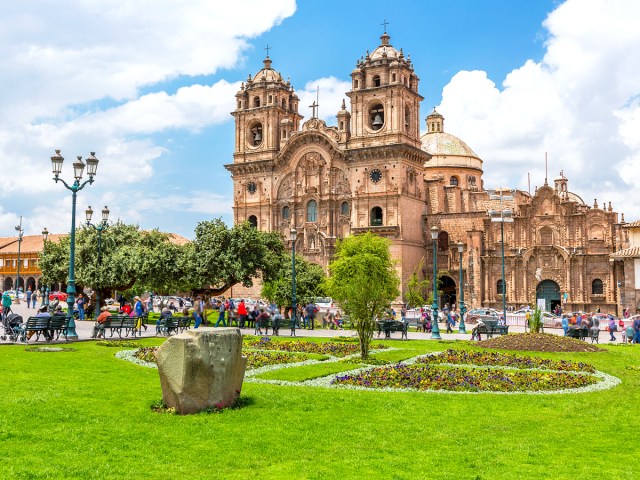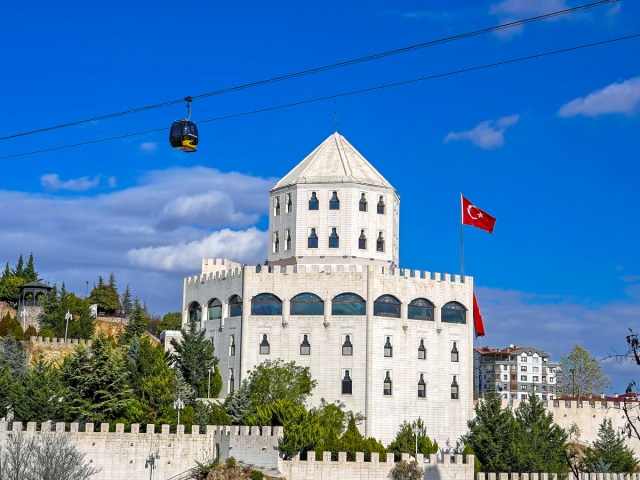While lacking in electricity, cars, planes, internet, telephones, modern medicine, and the printing press, ancient civilizations nevertheless thrived — teeming with complex art, architecture, religions, and rituals thousands of years ago. Thanks to the tireless work and findings of archaeologists and historians, we can begin to imagine what daily life was like back then. These 12 cities are among the most ancient cities in the world, and the remains left behind will leave you awestruck.
Samarkand, Uzbekistan

Formerly known as Maracanda, the Uzbek city of Samarkand is so old that it was around to be captured by Alexander the Great in 329 BCE. This cultural hub has long been an attractive and conquerable site for some of history’s most notable leaders, such as Genghis Khan, who destroyed Samarkand in 1220 CE, and Tamerlane, who made it the capital of his empire in 1366.
Today, there are ancient ruins in the Afrasiyab region, in the north of Samarkand, which date back to around 500 BCE. Many artifacts from this site can be found at the Afrasiab Museum, whose exhibits include frescoes and even excavated skeletons. You’ll also find the famed Afrasiab Painting in Samarkand — this seventh-century wall painting was found in a former private residence and depicts images that showcase how Samarkand played a key role in ancient trading along the Silk Road.
The city as a whole has earned an entry on the UNESCO World Heritage List, thanks to its many historic and colorful monuments. One (comparatively) modern landmark worth visiting is the Registan Mosque complex, which was built in the 15th century and is heralded for its vibrant azure mosaics.
Plovdiv, Bulgaria

While the majority of the oldest European cities are Greek, one notable exception is Plovdiv, Bulgaria — believed to be the oldest continually inhabited city on the continent. Now the second-largest city in the nation, this Bulgarian metropolis was inhabited as early as the sixth millennium BCE, according to researchers at the University of Pennsylvania. The centuries that followed saw ownership of the land fall into different hands — the region was conquered by Philip II of Macedonia and named Philippopolis in 341 BCE.
It later served as the capital city of the Roman province Thrace. Many ruins from that time are still standing, including a second-century amphitheater that the residents of Plovdiv use today for theatrical and dance performances. Plovdiv sits 12 miles northwest of Asen’s Fortress, a seemingly impenetrable mountain fortress with origins dating back to the fifth century BCE. Today, the site includes many ruins as well as a stunning 12th-century church overlooking the countryside.
Varanasi, India

This ancient city in northeastern India on the banks of the Ganges River is not only one of the oldest cities in the world, but it also comes with a treasure trove of insights into ancient Hindu culture. Varanasi is known as the spiritual capital of India, and civilizations have existed here for at least 3,000 years.
Legend has it that Lord Shiva founded this city 5,000 years ago, and Varanasi remains an important pilgrimage site for both Buddhists and Hindus who come to cleanse themselves in the Holy Ganges River at sunrise and sunset. It’s a moving experience to see and hear holy rituals performed by the Brahmins and watch as pilgrims purify themselves in the holy water. With the background of ancient temples set aglow by the rising and setting sun, other-worldly is the only way to describe this scene.
Tangier, Morocco

Tangier is a bustling port city in Morocco located 17 miles south of Spain, just across the Strait of Gibraltar. But long before it played a pivotal role in Moroccan commerce, it was an important site for the ancient Phoenicians. They founded the future city of Tangier as a colony named Tingis in the eighth century BCE. It was later overtaken by the Carthaginians and the Romans, the latter of whom conquered Tingis in 81 BCE.
One of the most notable archaeological sites in Tangier is a Roman Punic necropolis that’s home to 98 tombs once used by the ancient Phoenicians and Romans. Many of these tombs are carved directly into the rock, which helped preserve them for centuries amid the harsh natural elements. After centuries of war and shifting control, Tangier fell into the hands of the Moroccans in 1684.
Athens, Greece

Evidence suggests that Athens, one of the oldest cities in Europe, had bustling civilizations between the 11th and 7th centuries BCE. Home to Plato and Aristotle, Athens is the epicenter of ancient art and philosophy. It’s also said to be the birthplace of democracy, with far-reaching political influences over the rest of Europe. Piraeus Port boosted this city as a power player in trade development. Home to several prominent ancient monuments and UNESCO sites (the Parthenon, Acropolis of Athens, and Daphni Monastery, to name a few), the historical significance of this city cannot be overstated.
Aleppo, Syria

There is evidence to suggest that Aleppo, a city that, sadly, has been ravaged by recent civil war, could be the oldest city in the world. Signs of civilization have been found dating back 8,000 years. The number of eras this city has seen is apparent in its diverse mix of infrastructure. Ancient monuments like the Citadel of Aleppo, the Great Mosque — and countless other medieval buildings, walls, palaces, hammams, and souks — have earned the city a UNESCO World Heritage designation.
Its location, with the Mediterranean Sea to the west and the Euphrates River to the east, secured it a place in early history as a wealthy and prominent trading port. It’s hard to imagine how extraordinarily prosperous Aleppo was in the 16th and 17th centuries when faced with the present-day war that has wreaked havoc on the country. Despite its recent struggles, this city is easily one-of-a-kind, and hopes are high as efforts have begun to rebuild the city.
Byblos, Lebanon

With housing dating back to 5000 BCE, Byblos is one of the oldest continuously inhabited cities in the world. The once-humble fishing village grew into a bustling port and became famous for its workers skilled in ship making. The city’s name comes from its most sought-after export, the papyrus tree, which was used to make paper and upon which passages of the Bible were first said to be written. The English word “Bible,” after all, is derived from this city’s name.
The origin of our present-day alphabet also stems from this city, as it was partially carved into the stone coffin of King Ahiram around 1200 BCE. It became known as the Phoenician Tablet and was spread throughout the region by local traders. Today, Byblos is composed of a fascinating blend of ancient houses, Bronze Age temples, Persian fortifications, and Byzantine churches. It should come as no surprise that this city has been declared a UNESCO World Heritage Site.
Cuzco, Peru

The Peruvian city of Cuzco is located more than 11,000 feet above sea level within the Andes mountain range, making it one of the highest major cities in the world. Life in Cuzco dates back around 3,000 years, when the area was first inhabited by the Chanapata peoples. Some pottery from that early era survives today, though archaeologists have yet to uncover any ruins of larger settlements from that time.
Cuzco began to develop in earnest around the year 1200 CE, and it later served a key role in the Inca Empire, beginning in the 15th century. Among the Incan ruins that visitors can explore today is Coricancha, a once-gold-plated temple that was among the most significant sites in the empire. There are also ruins of 16th-century fortresses called Sacsayhuaman. And Cuzco is a mere 42 miles away from Machu Picchu, which can be accessed by train, by car, or even on foot from downtown Cuzco.
Ankara, Turkey

The bustling capital of Turkey was originally founded by the Hittites as Ankuwash sometime in the second millennium BCE, at the tail end of the Stone Age. The settlement was later conquered by Alexander the Great in 333 BCE and overtaken by Roman emperor Augustus in 25 BCE, before ending up in the hands of the Byzantine Empire.
Today, fascinating archaeological ruins can be found just a few miles away from the towering skyscrapers of Ankara. A highlight is Ankara Castle, or Ankara Kalesi, as it’s known in Turkish. The ancient Phrygian peoples built the earliest fortifications on this site around the eighth century BCE, and the castle complex was expanded under Roman rule toward the latter part of that millennium. Visitors can enjoy panoramic views of the city, embark on tours of the authentic Ankaran neighborhood built within the castle walls, and explore other fascinating artifacts that date back centuries.
Multan, Pakistan

Located along the Chenab River, Multan has served as a hub of civilization for many millennia. The origins of this city date back to the Harappan era some 5,000 years ago, forming the early foundations of what would become one of the biggest cities in Pakistan.
Multan is rife with relics and ruins that reflect its Hindu influences, many of which were razed during later conquerings. This includes the Prahladpuri temple, which is rumored to be where the festival of Holika Dahan — which occurs just prior to the Hindu festival Holi — originated many centuries ago. There are also many remnants of walls and citadels that possibly date back to the time of Alexander the Great’s siege in 325 BCE.
Yanshi, China

Yanshi, located in China’s Henan province, is a relatively modern city, but its history dates back millennia, as evidenced by the Erlitou archaeological site. Researchers uncovered evidence of parallel roads that date back anywhere from 3,500 to 3,800 years ago, showing that they employed a grid pattern found today in many modern cities. This is the earliest known evidence of this phenomenon found in China.
Historians believe that Yanshi once served as the capital of one of the earliest known Chinese dynasties, the Xia dynasty (2070 BCE to 1600 BCE). Yanshi isn’t exactly a tourist attraction today, as it lacks many of the amenities you’d associate with tourist cities around the world, but it sits just a few dozen miles west of Zhengzhou — a popular city with many attractions of its own.
Jericho, West Bank

Archaeological digs discovered the remains of civilizations from 9000 BCE around Jericho, making it one of the oldest settlements in the Middle East and one of the oldest cities in the world that still exists. Twenty different settlements have been unearthed by archeologists in Jericho, the earliest of which dates back 11,000 years.
While Jericho has a hot desert climate, it also has several natural springs in and around the city that have attracted civilizations for thousands of years. Its location in the Jordan Valley, 850 feet below sea level, also makes it the lowest ancient city in the world. The Jericho Tell (aka Settlement Mound) is the site where archeologists found many early remains, including the Mount of Temptation (mentioned in the Bible) and the cliff-side Saint George Monastery – founded in 480 CE.
More from our network
Daily Passport is part of Inbox Studio, which publishes content that uplifts, informs, and inspires.
















